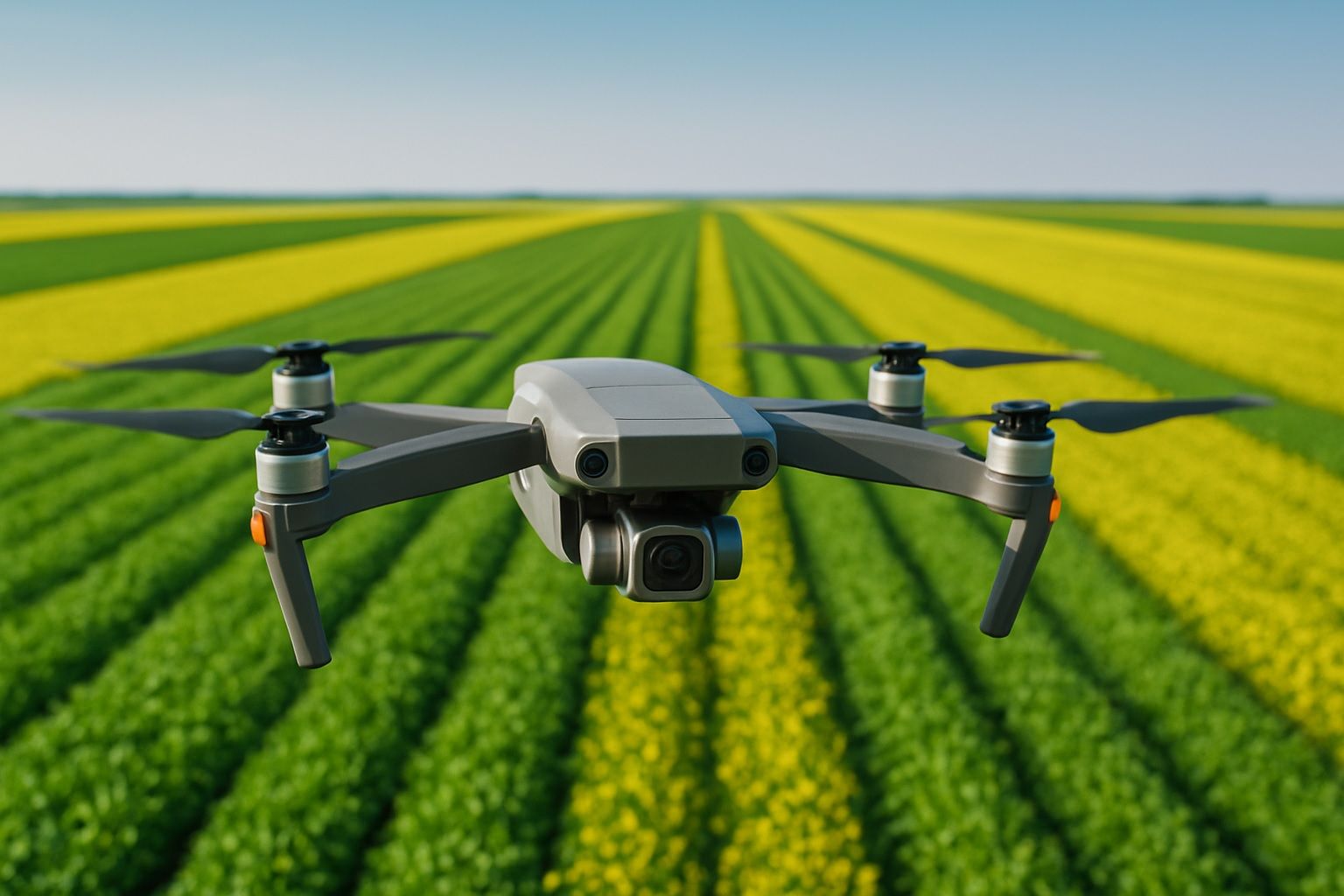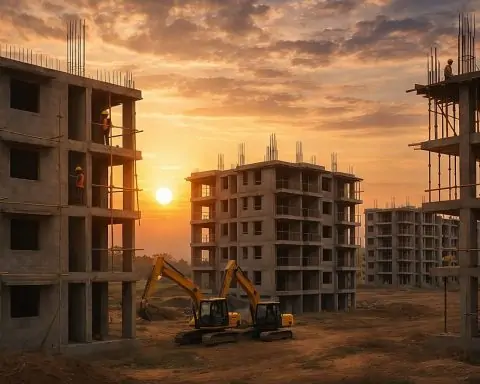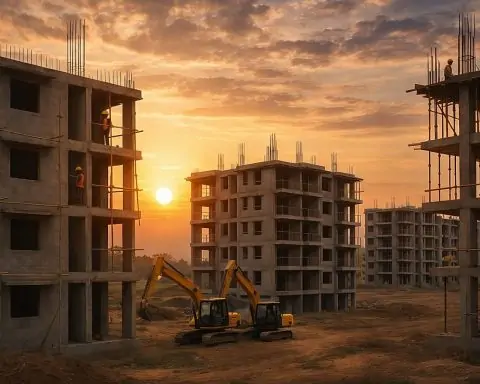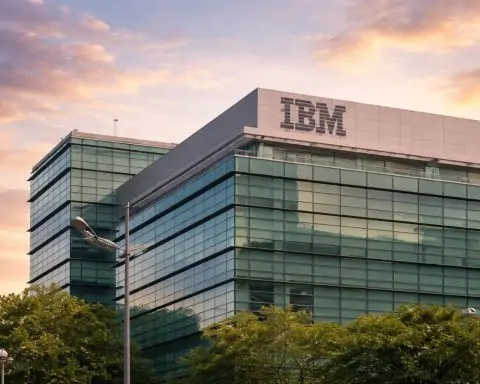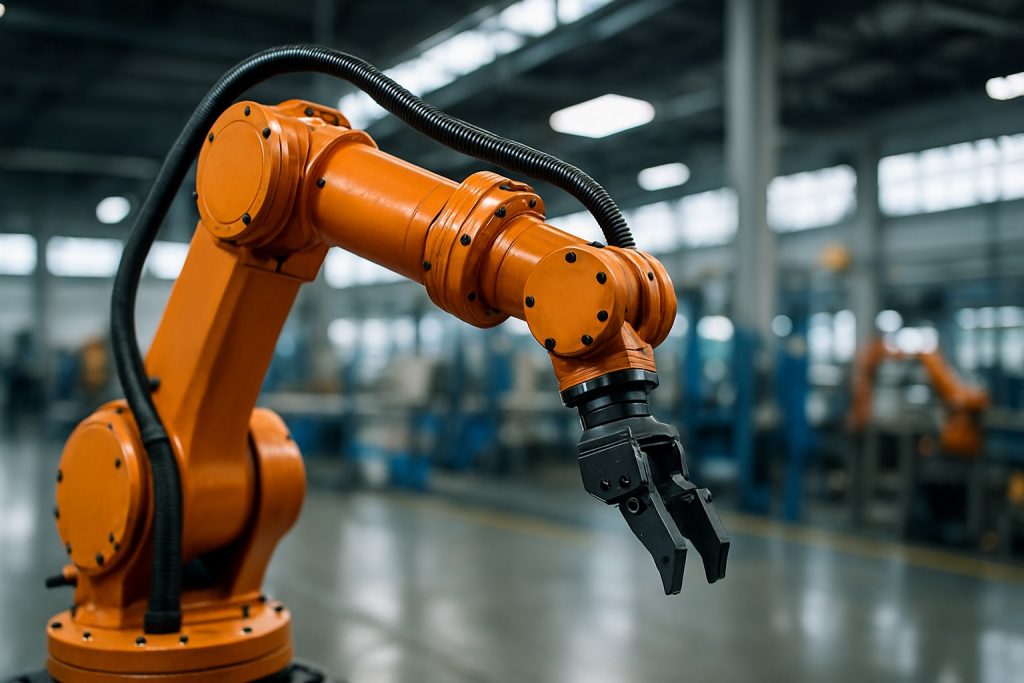Major News Developments in AgriTech (June–July 2025)
- Startup Investments: AgriTech startups attracted notable funding. For instance, California’s Shinkei Systems – a seafood automation company – raised a $22 million Series A to expand its humane fish-processing “Poseidon” technology [1]. In New Zealand, the AgriZeroNZ partnership invested in methane-cutting agtech startups to help farmers curb livestock emissions and meet 2030 climate targets [2]. These deals underscore continued investor interest in agri-innovation, from sustainable protein to climate-smart farming tools.
- Corporate Moves and Partnerships: Established agriculture players advanced their tech strategies. Kubota announced a collaboration with U.S. startup Agtonomy to add autonomous capabilities to its tractors, aiming to automate specialty crop spraying and mowing. This partnership is part of Kubota’s push to solve connectivity and data challenges in precision ag [3]. Meanwhile, beverage giant Suntory launched a pilot in regenerative agriculture to secure its future ingredient supply, after finding that practices like biochar and cover cropping can mitigate drought and heat risks. “We kept coming back to the same solution across many crops – regenerative agriculture,” explained a Suntory senior manager of global supply [4]. And John Deere signaled its commitment to agtech by doubling down on Brazil – at a June investor day in Indaiatuba, Brazil, Deere’s executives highlighted plans to boost yields, farm productivity, and rural connectivity through its digital platforms (Operation Center, JDLink) in the country’s booming farm sector [5].
- Innovation Hubs and Initiatives: New initiatives were launched to accelerate agtech innovation on the ground. In California, agtech accelerator The Reservoir partnered with grower Tanimura & Antle to establish a 40-acre “robotics incubator” farm, providing start-ups space to test robotic farming solutions in real field conditions [6]. This “purpose-built” hub aims to modernize agriculture by giving agtech ventures a pathway from pilot to scale. Across the Pacific, an array of research breakthroughs also made headlines (detailed below), reinforcing that June–July 2025 was a fertile period for agritech progress.
Innovations and Technology Deployments (AI, Drones, IoT, Robotics)
In mid-2025, numerous precision agriculture technologies moved from concept to field deployment. Automation and robotics saw significant strides: major manufacturers and startups alike introduced autonomous farm machinery to tackle labor shortages and improve accuracy. Kubota’s partnership with Agtonomy will outfit Kubota’s popular M5N narrow tractors with automation for tasks like spraying in vineyards and orchards, reducing labor needs and pesticide use [7]. Similarly, Monarch Tractor reported growing interest in its driverless electric tractors – “our latest feature, autonomous feed pushing, has seen strong uptake, especially from co-ops like Dairy Farmers of America,” said Monarch CEO Praveen Penmetsa [8]. Even non-traditional ag sectors are embracing farm robotics: demand is rising for solar farm maintenance robots (autonomous mowers and panel cleaners) as utilities build out solar arrays, and Monarch hinted at major partnerships in the works to service solar installations without human labor [9]. Major OEMs such as John Deere and Caterpillar are also expanding their automation portfolios, a trend that “signals strategic value” and suggests a clear path to commercializing ag robotics at scale [10].
Drones and UAVs are another area of rapid deployment. Unmanned aerial vehicles are increasingly used for crop spraying, imaging, and even farm logistics. Industry experts note that while technical barriers remain – limited flight times, small payload capacities, and regulatory constraints – farmers are becoming more receptive to drone technology as they see peers demonstrate its benefits [11]. “UAVs are increasingly being adopted for agricultural spraying, data collection, and emergency logistics,” observed Lukas Koch, CEO of Kelly Hills Unmanned Systems, adding that integration with data platforms is key to making drones truly ROI-positive tools [12]. In one example of innovation, a Kansas grower showcased an autonomous irrigation pivot system equipped with radar sensors that take up to 300 soil moisture readings per rotation – all without manual intervention – to precisely water crops only where needed [13]. These autonomous pivots exemplify how IoT devices are improving resource efficiency on the farm.
Advanced sensors and AI-driven analytics are further enhancing precision agriculture. In Singapore, researchers unveiled a breakthrough nanotech sensor capable of real-time monitoring of plant health by detecting a key growth hormone (IAA) in plants. This non-invasive nanosensor allows farmers to instantly gauge stress or nutrient needs across different crop species. According to Dr. Duc Thinh Khong of the Singapore-MIT research team, such technology can fundamentally improve day-to-day farming by providing “real-time, precise insights into plant health, enabling farmers to tailor irrigation, nutrient supply and pruning with greater accuracy… By catching signs of stress early, farmers can intervene promptly to prevent crop loss, optimise resource use and improve overall yields” [14]. These innovations – from smart tractors and drones to soil and plant sensors – all point toward a more data-driven, automated future on the farm.
Market and Investment Trends in AgriTech
The agri-tech industry in mid-2025 faced a challenging investment climate, though with bright spots in certain segments. According to PitchBook data, global AgTech venture funding dropped to $1.6 billion in Q1 2025 (across 137 deals) – a nearly 25% decline in deal count from the previous quarter [15]. This cooling follows record venture highs in 2021–22, and mirrors a broader VC pullback in sectors beyond the current AI boom. “AgTech’s challenges aren’t unique… what we’re seeing is part of a broader venture capital correction,” noted McKinsey partner Tom Brennan, commenting on the slowdown [16]. Weaker commodity prices and a sluggish farm economy in early 2025 also tempered valuations [17].
However, precision agriculture remains a relative bright spot for investors. Despite the overall VC dip, automation and smart farming tools continued to attract capital. Over the past 12 months (through mid-2025), the precision agriculture sector logged $1.82 billion in deal value, with especially strong growth (nearly +50% in value) in the “robotics and smart field equipment” sub-sector [18]. Labor shortages in agriculture are driving this trend – roughly “40% of U.S. ag labor is likely undocumented,” according to McKinsey’s Vasanth Ganesan, which creates “strong incentives for farmers to turn to robotics and automation” to maintain productivity [19]. Investors have taken note, fueling startups that address farm labor and efficiency challenges. For example, Monarch Tractor’s successful deployments in dairy farms and the emergence of robotic solutions for solar farm management (autonomous tractors servicing solar panels) demonstrate new growth markets for agri-tech beyond traditional cropping [20].
Another trend is the increasing role of corporate and strategic investors in agtech. Industry giants like Deere & Company and Caterpillar have been actively investing in agtech firms or developing in-house tech capabilities. “Big players entering the space signals strategic value… there’s now a clearer path to exit – which was not always the case in AgTech,” McKinsey’s Ganesan observed [21]. This convergence of agtech startups with large agri-businesses suggests that innovations are maturing toward integration in mainstream agriculture. Looking forward, market sentiment is cautiously optimistic that the funding environment will improve. Experts believe capital flow could rebound in late 2025 (barring major trade or economic disruptions), which would benefit established agtech companies ready to scale up [22]. In summary, the mid-2025 market saw a temporary dip in funding but continued strategic investment in automation, with expectations of a recovery on the horizon as agriculture’s digital transformation presses on.
Government and Regulatory Updates Affecting AgriTech
Government policies in June–July 2025 reflected a growing recognition of agtech and precision farming as strategic priorities:
- United Kingdom – AgriTech as a “Frontier” Industry: On June 23, the UK government’s new Industrial Strategy explicitly identified agri-tech as a key ‘frontier’ sector within its Advanced Manufacturing focus [23]. This strategy highlights agri-tech’s importance for economic growth, productivity, and climate resilience. In tandem, the UK’s Department for Environment, Food & Rural Affairs (Defra) committed £200 million through 2030 for a Farming Innovation Programme to spur home-grown agri-tech development and on-farm tech adoption [24]. “We welcome the government’s recognition of agri-tech as a frontier industry to deliver growth, boost productivity, build climate resilience and reduce emissions,” said Hannah Senior, CEO of the UK Agri-Tech Centre, praising the long-term support for agricultural innovation [25].
- UK – Biosecurity and Food Safety Investments: The British government also announced a record £1 billion investment to build a new National Biosecurity Centre in Surrey [26]. Confirmed on June 24 as part of the National Security Strategy, this state-of-the-art campus will strengthen the UK’s defenses against animal and plant diseases, with advanced labs for detecting and containing outbreaks [27] [28]. By modernizing biosecure facilities (replacing aging infrastructure at Weybridge), officials aim to protect food supply chains and farm industries from diseases like avian flu or African swine fever that could devastate agriculture [29]. This major public investment underscores how safeguarding agriculture and food security has become a national priority on par with human health security.
- European Union – Incentives for Precision Farming: In early June, the European Commission adopted a Water Resilience Strategy that includes support for climate-smart farming practices. A draft policy seen in Brussels proposes new subsidies to encourage farmers to invest in water-saving innovations – for example, growers who adopt precision irrigation systems (or plant more drought-tolerant crop varieties) could receive financial rewards under the post-2027 Common Agricultural Policy [30]. This push comes as Europe faces intense pressure on water resources from climate change. The strategy sets a target to cut EU water usage by 10% by 2030 and envisions “transition packages” to help farms modernize their water management [31] [32]. At the same time, EU regulators have shown flexibility by easing some environmental rules to reduce burdens on farmers, after protests last year. By balancing sustainability goals with farm viability, European authorities are nudging agriculture toward precision tech solutions (like drip irrigation, moisture sensors, and efficient pumps) to conserve water without sacrificing yields.
- Other Policy Developments: Around the world, several other government initiatives during this period signaled support for agri-tech. For instance, the U.S. Department of Agriculture (USDA) continued rolling out its Climate-Smart Agriculture programs and rural broadband investments (critical for digital farming), although a proposed Precision Agriculture Loan Program Act was still in legislative review in mid-2025. In Asia, countries like India announced new agri-tech incubators and pilot projects for AI in farming (often in partnership with the private sector), aiming to improve farm incomes through technology. And in Africa, policymakers at the African Union’s June summit highlighted precision agriculture as a tool to boost food production sustainably on the continent. Collectively, these regulatory moves and government funding efforts in June–July 2025 show a worldwide trend: public institutions are increasingly embracing agtech and precision farming as essential to future food security and environmental stewardship.
Expert Insights and Industry Forecasts
Industry leaders and analysts used the mid-2025 forums and reports to share insights on where agri-tech is headed:
- AI and the Future of Farming: A thought-provoking vision came from Mark S. Brooks – a climate scientist turned agtech investor – who argued that the convergence of advanced artificial intelligence with agriculture could be revolutionary. “When AGI meets agtech, we’re not just improving crops. We’re rewriting the operating system of life,” Brooks wrote, suggesting that AI at human-level intelligence will fundamentally change how we breed plants, manage farms, and even define agriculture itself [33]. Such bold predictions underscore the transformative potential of AI in agriculture, from automating complex decisions to re-engineering crops for resilience. Experts advise that the industry must be ready to adapt to these rapid changes in digital capability. On a policy note, agribusiness leaders like Hannah Senior have emphasized the need for enabling environments to realize this potential. Senior praised the UK’s long-term strategy, noting that forward-looking government support will help innovators and farmers plan for the next decade of agri-tech advances [34].
- On-the-Ground Adoption and Outlook: Practitioners report that many of the futuristic technologies are already taking hold at the farm level. “Our latest feature, autonomous feed pushing, has seen strong uptake,” said Praveen Penmetsa, CEO of Monarch Tractor, highlighting that dairy farmers are embracing robotics to automate labor-intensive tasks [35]. Such success stories indicate that even traditional farm operations can quickly integrate cutting-edge tech when there’s a clear ROI or labor-saving benefit. Likewise, in the aerial imagery space, early adopters are convincing others: Lukas Koch, a drone entrepreneur, observed that farmers are “increasingly receptive” to UAVs once they see peers validate the technology’s performance in the field [36]. This peer-to-peer influence is speeding up the acceptance of drones for crop scouting and spraying. Finally, looking at the bigger picture, agri-finance experts remain cautiously optimistic. They forecast that as interest rates stabilize and food demand climbs, AgTech investment will regain momentum. “For startups and innovators willing to navigate evolving dynamics, 2025 could mark the start of a new and transformative chapter for AgTech,” one industry report noted, pointing to the second half of 2025 as a potential inflection point. In summary, the consensus among agri-tech thought leaders is that the current challenges are temporary, and the coming years will bring smarter, more resilient farming powered by innovation – fulfilling both economic needs and sustainability goals in agriculture [37].
References
1. www.agtechnavigator.com, 2. www.agtechnavigator.com, 3. www.agtechnavigator.com, 4. www.agtechnavigator.com, 5. www.agtechnavigator.com, 6. www.agtechnavigator.com, 7. www.agtechnavigator.com, 8. www.reuters.com, 9. www.reuters.com, 10. www.reuters.com, 11. igrownews.com, 12. igrownews.com, 13. www.precisionfarmingdealer.com, 14. www.agtechnavigator.com, 15. www.reuters.com, 16. www.reuters.com, 17. www.reuters.com, 18. www.reuters.com, 19. www.reuters.com, 20. www.reuters.com, 21. www.reuters.com, 22. www.reuters.com, 23. ukagritechcentre.com, 24. ukagritechcentre.com, 25. ukagritechcentre.com, 26. www.cleanroomtechnology.com, 27. www.cleanroomtechnology.com, 28. www.cleanroomtechnology.com, 29. www.cleanroomtechnology.com, 30. www.reuters.com, 31. www.reuters.com, 32. www.reuters.com, 33. www.agtechnavigator.com, 34. ukagritechcentre.com, 35. www.reuters.com, 36. igrownews.com, 37. www.reuters.com
